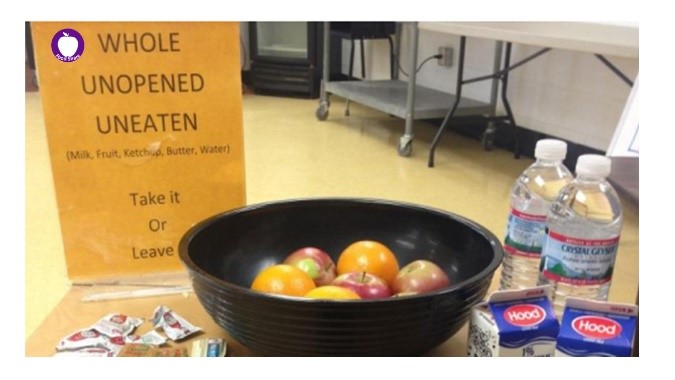
A "compost center" built by volunteers at Ferrisburgh Central School. Students monitor working compost piles in the shed as part of their school curriculum, and use their finished compost in the school garden.
MONTPELIER – Vermont’s K-12 schools are at the forefront of implementing the Universal Recycling law and using food education and local resources to cut down on food waste. They are successfully reducing waste, managing recyclable materials and creating food scrap diversion programs in exemplary form.
“In their classrooms and cafeterias, Vermont’s youth are learning important hands-on lessons about how simple and routine it can be to reduce waste, rescue food, recycle materials, and compost. It becomes natural,” said Department of Environmental Conservation Commissioner Emily Boedecker. “Schools are jumpstarting the market and demanding the pick-up, recycling and composting services we need to revamp our waste management system.”
Vermont schools make different choices about how they should best manage their waste; what works for one school might not work for another. Some schools compost on-site; some schools work with a local farm to manage food scraps; and some schools have hauler pickup of food scraps along with their recyclables and other waste. The wide variety of implemented solutions demonstrates the options and flexibility available to organizations and residents seeking to sustainably manage recyclables and organic waste.
Schools across the state are also working to address national food waste trends by using tools to decrease wasted food in their cafeterias and increase food donation rates. ‘Food Share tables’, where students can place unwanted food to be shared with their classmates rather than throwing the food in the trash, are an increasingly popular tool.

A "share table" at Milton Elementary School, where students leave behind unwanted, edible, uneaten food to share with other classmates instead of throwing items in the trash.
“Our schools are working hard to make sure students ‘clean their plates' first, but with all cafeterias there is going to be food scraps,” said Agency of Agriculture Secretary Anson Tebbetts. “We know teachers, students and food service workers are doing their best to manage waste.”
Though most schools are not required to separate food scraps until 2020, schools have been ahead of the curve because of the dedicated students, teachers, parents, and school employees who have been working for years to decrease food waste and manage food scraps. Schools have also received critical support from their solid waste districts or alliances and a rich network of Farm-to-School programming.
With Earth Day nearing, the Department is sharing and celebrating several examples of the successful leadership and innovation happening in Vermont schools with the goal of inspiring others:
-
St. Johnsbury Academy: In 2009, St. Johnsbury Academy initiated a food scrap diversion system by recruiting faculty volunteers to drive weekly deliveries of food scraps buckets from the school to the Paris Farm compost facility in Lyndon. When compost hauling services became available a few years later, the Academy transitioned to having their food scraps hauled by Black Dirt Farm.
-
Flood Brook School (Londonderry): Flood Brook School established a food scrap diversion system in 2015 by arranging weekly food scrap pickup from TAM Organics Inc., in conjunction with the hauler’s pick-up of food scraps from the nearby Londonderry Transfer Station.
-
Ferrisburgh Central School: In 2009, Ferrisburgh Central School realized that instead of sending food waste to the landfill while buying compost for their school garden, they could reduce their waste while making their own compost. Students led the process, meeting with the school board, collecting data on waste production, and consulting with the Highfields Center for Composting on design for an onsite composting system. The 4-bin system that resulted from that effort, built by parents, receives 20-40 pounds per day of food scraps and horse manure donated by a local farm. Running the compost system is part of the 5th and 6th grade curriculum, and composting is part of the day to day routine for students of all ages.
-
Milton Elementary and Middle School: Milton schools have share tables where “rescued food” (quality, edible food which would otherwise be wasted) is placed and then used for afterschool programs. “At Milton Elementary, the student Green Team set each classroom up with a compost bucket and share bin. It was a huge success,” said Rhonda Mace, School & Youth Outreach Coordinator at Chittenden Solid Waste District.
-
Sustainability Academy (Burlington): Uneaten and unopened food items left at the sort station by students are placed in a ‘Share Fridge’ in the lobby, where they can be accessed by members of the wider community.
- Putney Central School: With the support of the Vermont Agency of Agriculture, Food & Markets’ Milk Cooler Program, some schools have installed bulk milk dispensers, eliminating single-serving milk cartons from their waste streams and reducing wasted milk. At Putney Central School, 51,000 milk cartons were landfilled annually prior to switching to a bulk milk dispenser system.
These highlights represent a small sample of the achievements of many more schools across Vermont.
For more case studies on innovative waste management programs in Vermont schools and school waste reduction guides, visit the Department of Environmental Conservation Universal Recycling School Resource webpage.
For more information on the Agency of Agriculture Milk Cooler Program and Farm-to-School resources, visit the Vermont Farm to School Resource webpage.
# # #
